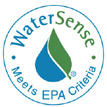Call to Action: What can you do to save America's water?
Water Conservation Techniques

Indoor water use percentage, including leakage for 1,188 data logged homes. Establishing Treatment System Performance Requirements. (2002). U.S. Environmental Protection Agency. Retrieved November 1, 2008 from EPA
- Save water in your home
- Toilets are the largest indoor water users in homes: Toilets use an average of 18.5 gallons per person per day (EPA, 2002),
- So, install a low-flow toilet that uses only 1.6 gallons of water per flush.
- Test toilets for leaks
- Use a toilet tank water displacement device to displace volume while still providing enough water for flushing
- Don't dispose unnecessary trash or other items in toilet; don't flush unnecessarily
- 2nd largest user is LAUNDRY: uses 15 gallons per person per day (EPA, 2002)
- Only operate washing machine when washing a full load (one load of laundry takes between 32 and 59 gallons of water)
- Avoid using hot water to conserve energy
- Wash on short cycle to conserve water energy
- When buying a new machine, check the water requirements! A good requirement is 30 gallons for a standard machine and 15 for a horizontal axis machine
- 3rd largest users are SHOWERS: uses 11.6 gallons per person per day (EPA, 2002)
- Install a low-flow showerhead that restricts the flow to 2.5 gallons per minute.
- Take short showers! Also, turn off the water while soaping.
- 4th largest users are FAUCETS: use 10.9 gallons per person per day (EPA, 2002)
- Don't let water run while you are not using it. Turn off the faucet when brushing your teeth! When washing your dishes, turn off the faucet while soaping.
- 5th largest users are LEAKS: use 9.5 gallons per person per day (EPA, 2002)
- Check your plumbing systems for leaks! Don't allow precious water to be wasted!
- Save water in the yard
- If you live in an arid location, you can save 50-75% of your current water usage by getting rid of your lawn (Water C.A.S.A., 2006).
- Replace your grass with desert landscaping: you'll save water and money.
- Convert your irrigation system to one that uses water more efficiently. Conventional spray heads lose a lot of water to evaporation in arid environments, so set up a drip system instead, but make sure to maintain it.
- Water your lawn early in the morning and remember to turn off your sprinkler system during rainy weather.
- Save water when you shop
- Buy products that meet EPA WaterSense criteria for water efficiency and performance (look for the WaterSense label)
- Pools
- Limit new pool construction Ð a 16 ft by 32 ft pool holds 20,000 gallons of water! (SAHRA, 2001)
- If you already have a pool, use a pool cover to save water that would be lost to evaporation- a pool loses an inch of water each week due to evaporation (SAHRA, 2001)!
- Pools seldom need to be drained, so minimize these occasions
- Do routine maintenance checks on the pool
- Public Awareness
- Educate yourself and others through our website and other sources on the efficient use of water resources
- Support legislation concerning the conservation of water
Remember that this is not just a crisis in Western North America. This is a global crisis.
The human race must step up and respect the rights of future generations. YOU can make a major difference, it may not be easy, but it does not take much to help change the world for the better.
|



